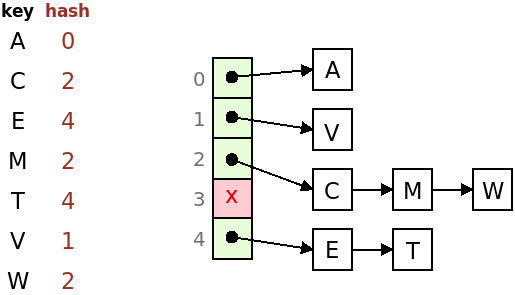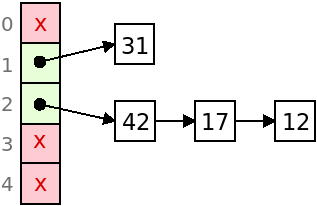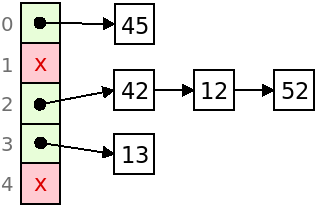 [AED067] Hash Tables with Separate Chaining
[AED067] Hash Tables with Separate ChainingIn what concerns the continuous evaluation solving exercises grade during the semester, you should submit until 23:59 of January 4th
(this exercise will still be available for submission after that deadline, but without couting towards your grade)
[to understand the context of this problem, you should read the class #11 exercise sheet]
 [AED067] Hash Tables with Separate Chaining
[AED067] Hash Tables with Separate ChainingIn this problem you should only submit a hashTableSC.h file with a self-containing definition of a class HashTableSC<KeyType>
Use as a basis the skeleton code of HashTableSC<KeyType> (see code | download code) which provides the initial code for a basic implementation of an hash table using separate chaining for collision resolution.
Implement the following 3 methods (which already exist on the given file, but still lack functional code):
In all methods, to find the corresponding position (bucket) on the table, use modular hashing over the hash function of the class (that was initialized on the constructor), that is, for key k the position can be found calling hash(k) % size.
On methods insert and remove, don't forget to update the numberKeys variable to reflect the change on the number of inserted keys.
You should submit the file hashTableSC.h with the methods contains, insert and remove implemented as requested (and without removing any of the other existing methods). You can however create additional methods, if you need them.
Mooshak will use the following code to link to your class, construct the hash table, read the operations and call your methods, printing its result.
#include <string> #include "hashTableSC.h" // Read hash table and then q operations template <typename KeyType> void read() { int n; std::cin >> n; std::hash<KeyType> h; HashTableSC<KeyType> hashTable(n, h); int q; std::cin >> q; for (int i=0; i<q; i++) { std::string op; KeyType k; std::cin >> op; if (op == "CONTAINS") { std::cin >> k; std::cout << "contains(" << k << "): " << hashTable.contains(k) << std::endl; } else if (op == "INSERT") { std::cin >> k; std::cout << "insert(" << k << "): " << hashTable.insert(k) << std::endl; } else if (op == "REMOVE") { std::cin >> k; std::cout << "remove(" << k << "): " << hashTable.remove(k) << std::endl; } else if (op == "SHOW") { std::cout << "showContents():" << std::endl; hashTable.showContents(); } } } int main() { std::string type; std::cin >> type; if (type == "int") read<int>(); else if (type == "string") read<std::string>(); return 0; }
| Example Input | Example Output |
int 5 17 INSERT 42 INSERT 17 INSERT 12 INSERT 31 INSERT 42 CONTAINS 17 CONTAINS 52 SHOW INSERT 45 INSERT 52 INSERT 13 REMOVE 17 REMOVE 31 REMOVE 31 CONTAINS 17 CONTAINS 52 SHOW |
insert(42): 1 insert(17): 1 insert(12): 1 insert(31): 1 insert(42): 0 contains(17): 1 contains(52): 0 showContents(): Size: 5 | Number of keys: 4 | Load Factor: 0.800 0: EMPTY 1: 31 2: 42 17 12 3: EMPTY 4: EMPTY insert(45): 1 insert(52): 1 insert(13): 1 remove(17): 1 remove(31): 1 remove(31): 0 contains(17): 0 contains(52): 1 showContents(): Size: 5 | Number of keys: 5 | Load Factor: 1.000 0: 45 1: EMPTY 2: 42 12 52 3: 13 4: EMPTY |
Explanation of the Example Input:
An empty hash table is initially created with 5 buckets. Afterwards:

